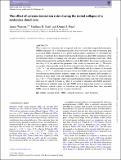Files in this item
The effect of extreme ionization rates during the initial collapse of a molecular cloud core
Item metadata
| dc.contributor.author | Wurster, J. | |
| dc.contributor.author | Bate, Matthew R | |
| dc.contributor.author | Price, Daniel J | |
| dc.date.accessioned | 2019-10-25T09:30:03Z | |
| dc.date.available | 2019-10-25T09:30:03Z | |
| dc.date.issued | 2018-05 | |
| dc.identifier | 262150134 | |
| dc.identifier | c9d36e7d-2c63-4e14-b8e8-4ddcaba7a373 | |
| dc.identifier | 85055146330 | |
| dc.identifier.citation | Wurster , J , Bate , M R & Price , D J 2018 , ' The effect of extreme ionization rates during the initial collapse of a molecular cloud core ' , Monthly Notices of the Royal Astronomical Society , vol. 476 , no. 2 , pp. 2063-2074 . https://doi.org/10.1093/mnras/sty392 | en |
| dc.identifier.issn | 0035-8711 | |
| dc.identifier.other | Bibtex: WursterBatePrice2018ion | |
| dc.identifier.other | ORCID: /0000-0003-0688-5332/work/63716923 | |
| dc.identifier.uri | https://hdl.handle.net/10023/18764 | |
| dc.description.abstract | What cosmic ray ionization rate is required such that a non-ideal magnetohydrodynamics (MHD) simulation of a collapsing molecular cloud will follow the same evolutionary path as an ideal MHD simulation or as a purely hydrodynamics simulation? To investigate this question, we perform three-dimensional smoothed particle non-ideal MHD simulations of the gravitational collapse of rotating, one solar mass, magnetized molecular cloud cores, which include Ohmic resistivity, ambipolar diffusion, and the Hall effect. We assume a uniform grain size of ag = 0.1 μm, and our free parameter is the cosmic ray ionization rate, ζcr. We evolve our models, where possible, until they have produced a first hydrostatic core. Models with ζcr ≳ 10−13 s−1 are indistinguishable from ideal MHD models, and the evolution of the model with ζcr = 10−14 s−1 matches the evolution of the ideal MHD model within 1 per cent when considering maximum density, magnetic energy, and maximum magnetic field strength as a function of time; these results are independent of ag. Models with very low ionization rates (ζcr ≲ 10−24 s−1) are required to approach hydrodynamical collapse, and even lower ionization rates may be required for larger ag. Thus, it is possible to reproduce ideal MHD and purely hydrodynamical collapses using non-ideal MHD given an appropriate cosmic ray ionization rate. However, realistic cosmic ray ionization rates approach neither limit; thus, non-ideal MHD cannot be neglected in star formation simulations. | |
| dc.format.extent | 12 | |
| dc.format.extent | 3796388 | |
| dc.language.iso | eng | |
| dc.relation.ispartof | Monthly Notices of the Royal Astronomical Society | en |
| dc.subject | Magnetic fields | en |
| dc.subject | MHD | en |
| dc.subject | Methods: numerical | en |
| dc.subject | Stars: formation | en |
| dc.subject | QB Astronomy | en |
| dc.subject | QC Physics | en |
| dc.subject | T-NDAS | en |
| dc.subject.lcc | QB | en |
| dc.subject.lcc | QC | en |
| dc.title | The effect of extreme ionization rates during the initial collapse of a molecular cloud core | en |
| dc.type | Journal article | en |
| dc.contributor.institution | University of St Andrews. School of Physics and Astronomy | en |
| dc.identifier.doi | https://doi.org/10.1093/mnras/sty392 | |
| dc.description.status | Peer reviewed | en |
| dc.identifier.url | https://arxiv.org/abs/1802.04872 | en |
This item appears in the following Collection(s)
Items in the St Andrews Research Repository are protected by copyright, with all rights reserved, unless otherwise indicated.

